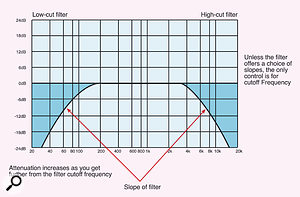What Does A Low Pass Filter Do
You are hither
Q. What are filters and what do they do?
I always hear people talking nearly low‑pass filters and high‑pass filters and cutting at this and that frequency, but where do you get these filters from? I don't think I have one in my Cakewalk Project 5 software. Are they part of equalisers?
Via SOS web site
 This diagram illustrates both low‑pass (high cut) and high‑pass (low‑cut) filtering. The shaded areas in the diagram will be attenuated.
This diagram illustrates both low‑pass (high cut) and high‑pass (low‑cut) filtering. The shaded areas in the diagram will be attenuated.
SOS Technical Editor Hugh Robjohns replies: People sometimes use the terms 'EQ' and 'filter' interchangeably, and so it'south understandable that you might be dislocated. We've published several introductory guides to EQ, most recently in SOS Dec 2008 (/sos/dec08/articles/eq.htm), so if you're a bit baffled virtually the broader discipline of EQ, it would be well worth reading this.
Substantially, EQ is used to boost or benumb (turn downwardly) a range of frequencies in order to shape a sound. High‑pass and low‑pass filters are common in professional equalisers, simply less mutual in budget designs. They are used to define the highest and everyman frequencies of interest in the signal and they pretty much do what their names suggest: permit sound above a certain frequency pass (loftier‑pass filter) or audio below a sure frequency pass (low‑pass filter). Annihilation exterior those limits is adulterate. They are also chosen depression‑cut or loftier‑cutting filters, merely the function is the aforementioned.
Filters are defined by their slope, which determines the attenuation of signals outside the 'pass' band. Almost audio filters on mixing desks (and DAWs) will accept a slope of 12dB or 18dB per octave, and in synthesizer filters the slope may be as steep as 24dB per octave. If an 18dB/octave high‑pass filter is fix to 80Hz, any sound an octave below that (at 40Hz) will exist attenuated by 18dB, and an octave lower notwithstanding, at 20Hz, it will be attenuated by 36dB... and so on.
Loftier‑ and low‑laissez passer filters generally have much steeper slopes than the more than normal equaliser bands (which are typically simply 6dB/octave) and are intended for a dissimilar purpose. Y'all can't effectively remove rumble with a bass EQ control, but you can with a loftier‑pass filter. Merely as, you can't shape the tone of a bass guitar with a high‑pass filter as easily as you can with a bass EQ control.
Filters are used for 'cosmetic' equalisation, equally opposed to artistic equalisation. They are used to clean upwardly a point, rather than to shape the audio creatively. They only provide attenuation of unwanted frequencies, and there's no telescopic to heave any part of the frequency range. Of the 2, the high‑pass filter is probably the most useful, as information technology helps to remove unwanted rumbles and other unwanted sub‑sonic rubbish that microphones tend to capture. Most DAW software includes a software EQ that you'll be able to employ to perform any of these tasks, and although I'yard not personally familiar with Cakewalk Projection five, I discover that it can host 3rd‑party VST plug‑ins, then there are many freeware plug‑ins that you could use if your DAW doesn't take them congenital in.
What Does A Low Pass Filter Do,
Source: https://www.soundonsound.com/sound-advice/q-what-are-filters-and-what-do-they-do
Posted by: tedescobutibill79.blogspot.com


0 Response to "What Does A Low Pass Filter Do"
Post a Comment